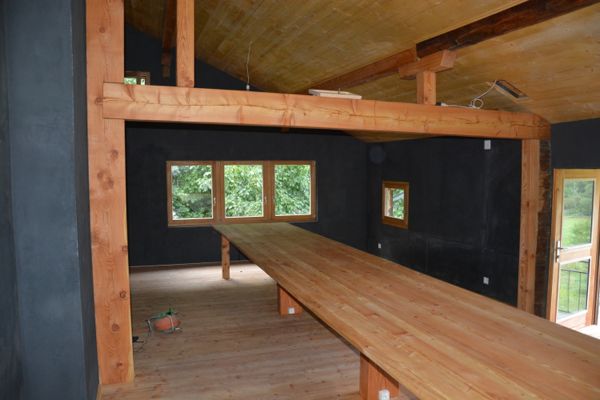
 5
5





Permaculture...picking the lock back to Eden since 1978.
Pics of my Forest Garden

 1
1




"Never doubt that a small group of thoughtful, committed citizens can change the world; indeed, it's the only thing that ever has."-Margaret Mead "The only thing worse than being blind, is having sight but no vision."-Helen Keller
 1
1




I make a Maple Syrup instructional movie! Check it out HERE
SKIP books, get 'em while they're hot!!! Skills to Inherit Property
See me in a movie building a massive wood staircase:Low Tech Lab Movie




Permaculture...picking the lock back to Eden since 1978.
Pics of my Forest Garden
 1
1








Permaculture...picking the lock back to Eden since 1978.
Pics of my Forest Garden




Iterations are fine, we don't have to be perfect
My 2nd Location:Florida HardinessZone:10 AHS:10 GDD:8500 Rainfall:2in/mth winter, 8in/mth summer, Soil:Sand pH8 Flat














Based on the article and discussion seen at the link provided.
It would seem that it is best for odor control and humidity control.
And is wonderful for internal walls but not so much for insulating external walls.
It can be added to the outside of a house as a "facade" that stores carbon vs letting it enter the atmosphere to become a greenhouse gas.
To me seems to be as insulating as cob, not horrible but not the best for wet, humid cold Maine.
If the walls are thick enough say 24inches. It is still doable.
These properties mean that biochar is just the right material for insulating buildings and regulating humidity.
Biochar can be applied to the outside walls of a building using standard plaster spraying or rendering equipment. Applied at a thickness of up to 20 cm, it can be a substitute for Styrofoam. Through the use of biochar-based insulation material, houses can become very long-term carbon sinks,
"Never doubt that a small group of thoughtful, committed citizens can change the world; indeed, it's the only thing that ever has."-Margaret Mead "The only thing worse than being blind, is having sight but no vision."-Helen Keller










 1
1




"Never doubt that a small group of thoughtful, committed citizens can change the world; indeed, it's the only thing that ever has."-Margaret Mead "The only thing worse than being blind, is having sight but no vision."-Helen Keller


 3
3




Iterations are fine, we don't have to be perfect
My 2nd Location:Florida HardinessZone:10 AHS:10 GDD:8500 Rainfall:2in/mth winter, 8in/mth summer, Soil:Sand pH8 Flat














Did anyone mention straw bale walls blackened with char? I'm not sure what you are referring to there.These walls are cob walls not strawbale walls that have been blacken.
Cob is usually made with straw, clay, and sand. Sand is not porous. It's quite dense, and when the spaces between sand particles are taken up by clay, then any air pockets that might exist in a given volume of straight sand are eliminated. Cob generally is dense and as you mention, S Bengi, is not a very good insulator at all. The amount of trapped air is minimal. Cob is a great thermal mass.Cob is made from clay and straw/biochar.
And while strawbale is a great insulator, sadly cob is not, In fact 12inches of cob has a R3 value.
Until studies can conclude the moisture/insulation conundrum that is discussed only briefly after the article, I don't know if we can really discuss the merits or detriments of char wall insulation with any degree of accuracy/certainty.In combination with clay, but also with lime and cement mortar, biochar can be used as an additive for plaster or for bricks and concrete elements at a ratio of up to 80%.
Strawbale itself is an alright insulator, but it is a better combination material that has attributes of thermal mass and insulation that create great thermal qualities. Straw bales are dense and quite massive, particularly if they are packed with tighter bindings-as is recommended when using them for constructing buildings. I've had a hand in building a few. While having thick walls can be a problem with eating up floor area, I don't see what other problems are associated with the thick walls beside the need to accommodate that in your design. A Char wall with 80% char in a cob type mix, I figure is going to be lighter and a lot better insulation (R value) than a straw bale, but it might not have the same thermal mass potential. I don't know. That's just how I see it.Even strawbale walls which are 'good insulator' have a thickness of 18inches.
So yes a 18inch or 24 inch biochar-COB might be okay. But we are still talking about 4x normal thickness wall.
"Never doubt that a small group of thoughtful, committed citizens can change the world; indeed, it's the only thing that ever has."-Margaret Mead "The only thing worse than being blind, is having sight but no vision."-Helen Keller


 1
1




Iterations are fine, we don't have to be perfect
My 2nd Location:Florida HardinessZone:10 AHS:10 GDD:8500 Rainfall:2in/mth winter, 8in/mth summer, Soil:Sand pH8 Flat




S Bengi wrote:
Real 100% BioChar Wall = 100% pyrolyzed strawbale/wood
Permaculture...picking the lock back to Eden since 1978.
Pics of my Forest Garden




Permaculture...picking the lock back to Eden since 1978.
Pics of my Forest Garden






















I imagine that a specialized system would have to be built such that a straw bale fit pretty much solidly (except for a few slots going down the side for gasses to move) into the inner chamber of a retort, and or, in a space for a certain amount of other material on top of a 'TLUD such that a bed of coals and downward movement of gasses was established before the coal began to form on the bale. Not sure. Just guessing. It could definitely be done in an industrial system.Has anyone here successfully pyrolised a strawbale? Not saying it's impossible, mind you, but think for a moment about the logistics.
"Never doubt that a small group of thoughtful, committed citizens can change the world; indeed, it's the only thing that ever has."-Margaret Mead "The only thing worse than being blind, is having sight but no vision."-Helen Keller
 1
1




 3
3




Permaculture...picking the lock back to Eden since 1978.
Pics of my Forest Garden
 1
1




Kevin Young wrote:Just wondering--has anyone tried a rocket oven for making char? Since it is closed off and the fire is not actually inside the oven, it seems that you could cram the whole oven full of material and make a large amount of biochar all at once very efficiently. Having never used a rocket oven (I only heard about it with the recent kickstarter), I do not know if it is air tight enough to do this, nor do I know if it would harm the oven in some fashion. Thoughts?
I make a Maple Syrup instructional movie! Check it out HERE
SKIP books, get 'em while they're hot!!! Skills to Inherit Property
See me in a movie building a massive wood staircase:Low Tech Lab Movie


 1
1




Iterations are fine, we don't have to be perfect
My 2nd Location:Florida HardinessZone:10 AHS:10 GDD:8500 Rainfall:2in/mth winter, 8in/mth summer, Soil:Sand pH8 Flat




Mike Jay wrote:When you're making char in a low oxygen environment you are driving off the volatile gasses. In the rocket oven case, I think those gasses would exit the gaps between the door and the oven. That might be totally fine. But if they were ignited, it could give a nice bit of ambient heat, or burn your house down, not sure which?




I make a Maple Syrup instructional movie! Check it out HERE
SKIP books, get 'em while they're hot!!! Skills to Inherit Property
See me in a movie building a massive wood staircase:Low Tech Lab Movie










 2
2




"Never doubt that a small group of thoughtful, committed citizens can change the world; indeed, it's the only thing that ever has."-Margaret Mead "The only thing worse than being blind, is having sight but no vision."-Helen Keller




Greg Martin wrote:Hi Travis. Partially charred wood has that smell, but fully and properly produced biochar/charcoal has no odor. Properly produced biochar reaches a temperature of almost 1000F. At those temperatures there is nothing volatile left to produce smells. But partially charred wood still has lots of volatiles in it that were produced during the burn. Due to it's absorptive high internal surface area biochar will actually absorb odors, not emit them.
 1
1





Permaculture...picking the lock back to Eden since 1978.
Pics of my Forest Garden










 1
1




"Never doubt that a small group of thoughtful, committed citizens can change the world; indeed, it's the only thing that ever has."-Margaret Mead "The only thing worse than being blind, is having sight but no vision."-Helen Keller


 1
1




Iterations are fine, we don't have to be perfect
My 2nd Location:Florida HardinessZone:10 AHS:10 GDD:8500 Rainfall:2in/mth winter, 8in/mth summer, Soil:Sand pH8 Flat




Roberto pokachinni wrote:I remember seeing Travis' photos and description. I think the main problem with Travis's method was that he used large log rounds (like firewood rounds) piled up in a heap in a pit, which would, in my way of thinking, have too much air gaps between the rounds. There was too much oxygen in his pit, and the wood. Then when he buried it, the excess oxygen burned off the rest to ash. Is that accurate to your method, and the way you might see it, Travis? I can't remember exactly what you had written.






 1
1




Iterations are fine, we don't have to be perfect
My 2nd Location:Florida HardinessZone:10 AHS:10 GDD:8500 Rainfall:2in/mth winter, 8in/mth summer, Soil:Sand pH8 Flat
 1
1




 2
2




 2
2




Please give me your thoughts on my Affordable, double-paned earthbag window concept





















 2
2




Greg Martin wrote:I didn't see much of anything here about using biochar as thermal insulation in natural building, so here's a link...enjoy!
The Use of Biochar as Building Material: https://www.biochar-journal.org/en/ct/3
First tests to produce biochar bricks using cement, lime or mud as a binder are very promising. With wet bulk densities under 1.2 g/cm3 and partly under 1 g/cm3 and a compressive strengths around 20 N/mm2, it would seem that a very exciting, highly functional lightweight material will soon be making its appearance. When using cement and lime, sand can be completely replaced by biochar reducing the weight of the material by factor 5 (see picture with the swimming bricks).
 2
2




 5
5














 7
7





"Never doubt that a small group of thoughtful, committed citizens can change the world; indeed, it's the only thing that ever has."-Margaret Mead "The only thing worse than being blind, is having sight but no vision."-Helen Keller

|
What's a year in metric? Do you know this metric stuff tiny ad?
The new gardening playing cards kickstarter is now live!
https://www.kickstarter.com/projects/paulwheaton/garden-cards
|








